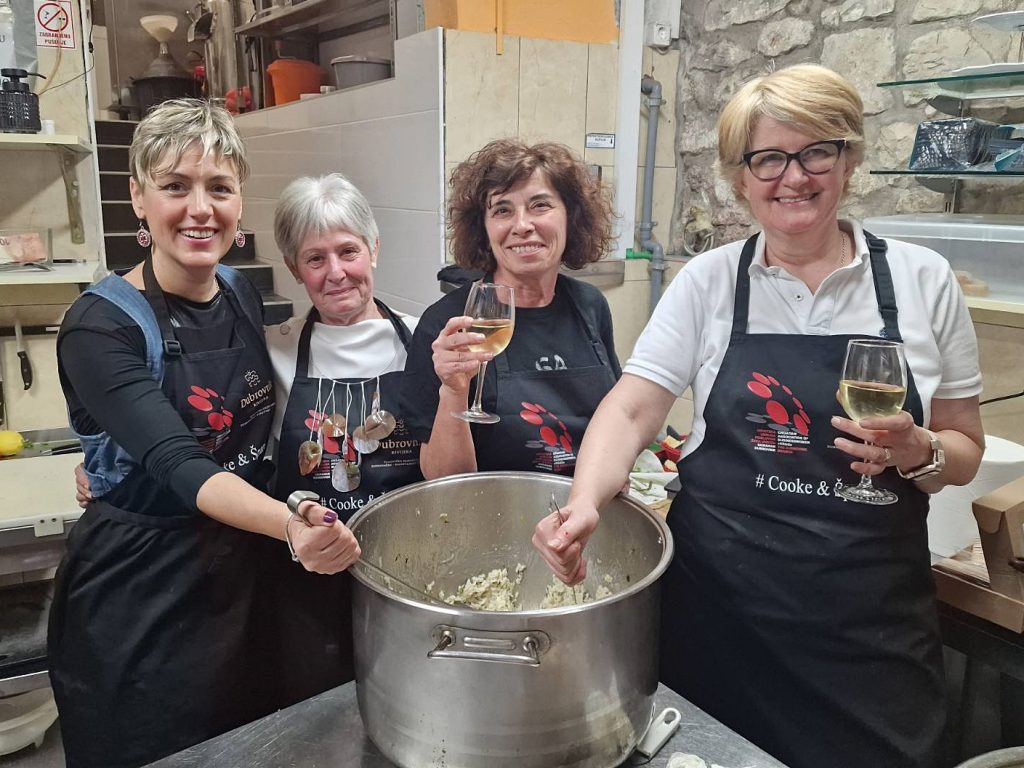April the 10th, 2025 – Down in Cavtat in the atmosphere of spring, Konavle asparagus is in full season. Learn more about this priceless health food that has been part of the local diet for millennia.
Dubrovnik businesswomen from the Krug association decided to organise a unique presentation and culinary workshop called “COOKe & asparagus” dedicated to this invaluable locally growing food. Konavle and one of its most successful local agrotourism businesses, the Novaković Farmhouse, were chosen as the venue, all through the co-organisation of the Konavle Agrotourism Association.
celebrating the queen of spring – konavle asparagus

The intention was not only to present the Croatian queen of spring through interesting lectures, but also to prepare a series of tasting dishes in which this food is used. Most fans of wild Konavle asparagus actually enjoy the entire cycle of preparing such dishes – from searching for the asparagus itself, growing wild in various places in nature, then picking it, preparing it and finally – sitting down and enjoying it.
Those involved in the workshop did precisely that. They picked the wild Konavle asparagus precisely for this event at several locations and then prepared it all over several days. This was done to make sure that the finished dishes would be ready on the day of the presentation at the Novaković restaurant’s kitchen.
These professionals in their jobs showed no less experience in the culinary sense. The first chefs were Stanka and Seka Divizić, from whose pot four dishes made from wild Konavle asparagus, and were then served. These were flavoursome risotto, pesto, salad and of course – asparagus soup.
a super food for human health
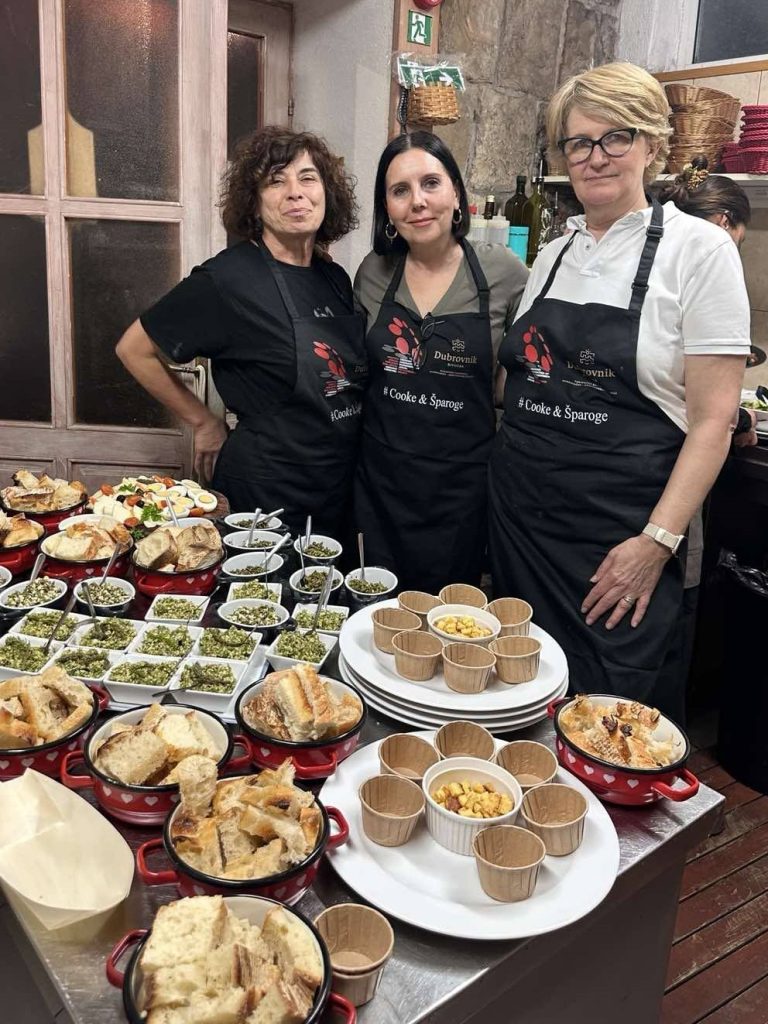
This was all rounded off gastronomically – as it had begun – with a selection of sweet dishes, and everything was accompanied by a glass of Pegasos wine from the Dubrava Winery on the Pelješac peninsula. Konavle asparagus is undoubtedly one of the most appreciated seasonal foods that has been used in cooking and medicine for centuries in southern Dalmatia. This delicate plant, as emphasised one of the lecturers Šime Martinović from Labin in Istria, actually belongs to the beautiful lily family. Its very young shoots, which are harvested during the spring, are incredibly rich in nutrients and have an extremely beneficial effect on human health.
As stated, asparagus is one of the most valued seasonal foods that has been used for centuries in cooking and medicine. There is enormous potential for growing wild asparagus in olive groves and gardens, with minimal costs. This extends the possibility of consuming this priceless food throughout the year. In addition to all of that, we already know just how Konavle asparagus can be used within a wider local gastronomic story, and for the purpose of tourism.
a friend of the immune system
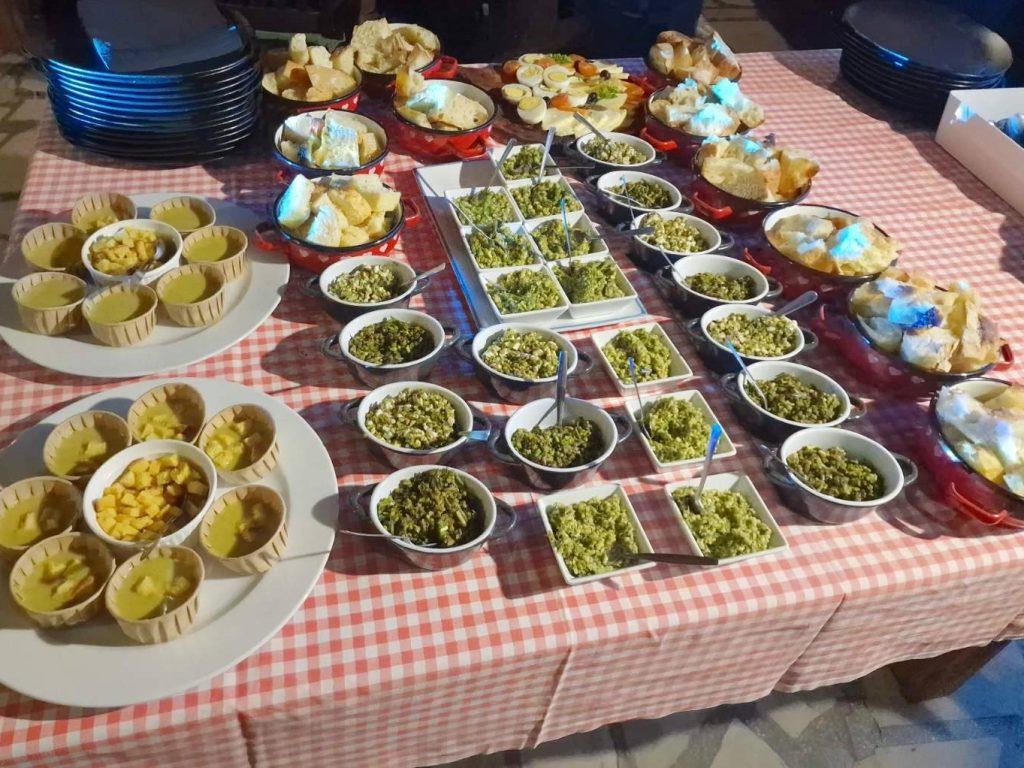
Šime Martinović is better known by the nickname “Šjor Šime asparagus”. The name along speaks volumes. This asparagus enthusiast and pioneer in growing wild asparagus in Croatia brought with him and shared more than fifty wild asparagus seedlings that he grew himself.
After all, its seedlings are already growing wild all over Croatia, and three asparagus lovers from the Dubrovnik area have already planted them. Master Mihaela Gavrić from the Dubrovnik Pharmacy Čebulc spoke about the nutritional benefits of asparagus, especially wild Konavle asparagus. She emphasised why asparagus should be included in our diet much more often, and what an ally it can be when it comes to building up our immune system.
It is less well known that asparagus has diuretic properties that help detoxify the body, while antioxidants protect cells from damage and slow down the dreaded ageing process. Asparagus, as emphasised by Master Gavrić, isn’t only a delicious food, but also a true ally of human health.
The people of Konavle showed particular interest in the lecture by asparagus expert Šime Martinović. This Istrian began his story about twenty years ago when he received his first seeds from Dalmatia and planted them in his garden. His growing method allows for the asparagus to grow under olive, fig and other fruit trees, thus maximising the use of agricultural land. He also spoke more about how Konavle asparagus can further contribute to the development of agro-tourism and sustainable agriculture, before distributing seeds.
the cultural and gastronomic value of asparagus
Asparagus was well known for its positive properties as far back as Ancient Egypt and Rome, where it was considered a luxury food. Today, it is used in a variety of cuisines around the world – from simple salads to sumptuous dishes like the risotto served at the COOKe & asparagus event. Its mild, nutty flavour pairs perfectly with olive oil, parmesan cheese or eggs.
wild or cultivate asparagus – which is better?
Wild asparagus, has a more intense flavour and thinner shoots than cultivated varieties. Harvesting it requires patience and skill, making it a true delicacy for nature lovers. Cultivated asparagus, on the other hand, is available on the market year-round and comes in green, white, or purple varieties.
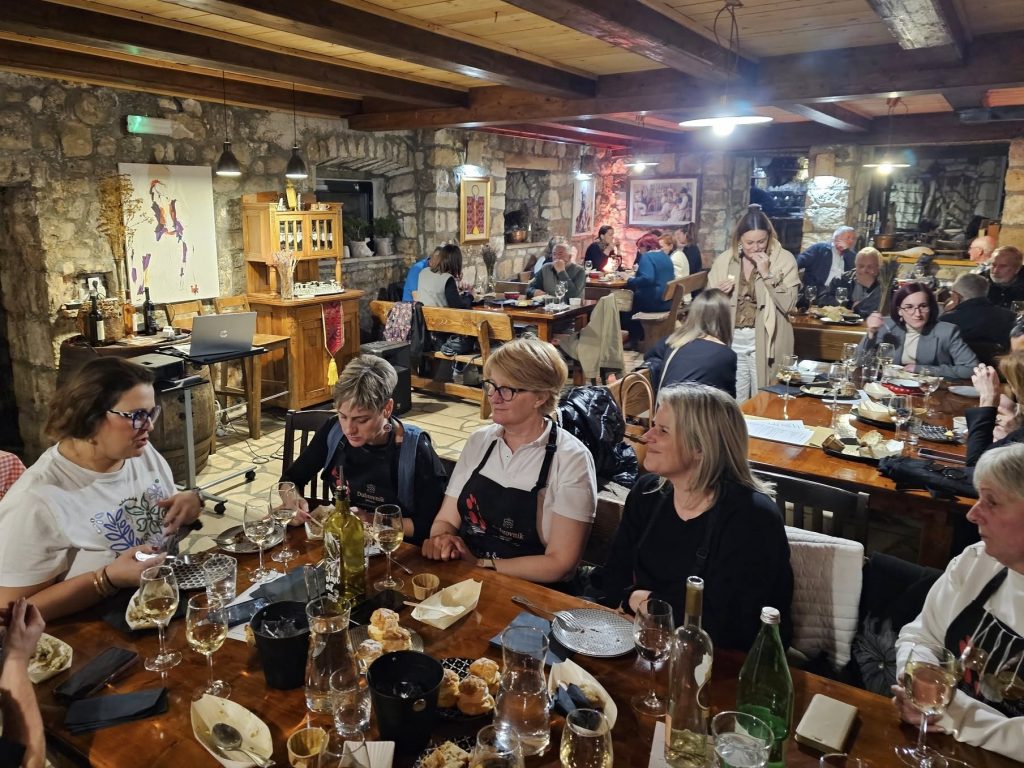
asparagus season
The spring months are the perfect time to enjoy fresh asparagus, whether that happens to be the Konavle wild asparagus variety or any other. You can often find home-grown asparagus sold at local markets, which guarantees quality and freshness. If you want to save it for later, you can also blanch and freeze it.
favourite recipes
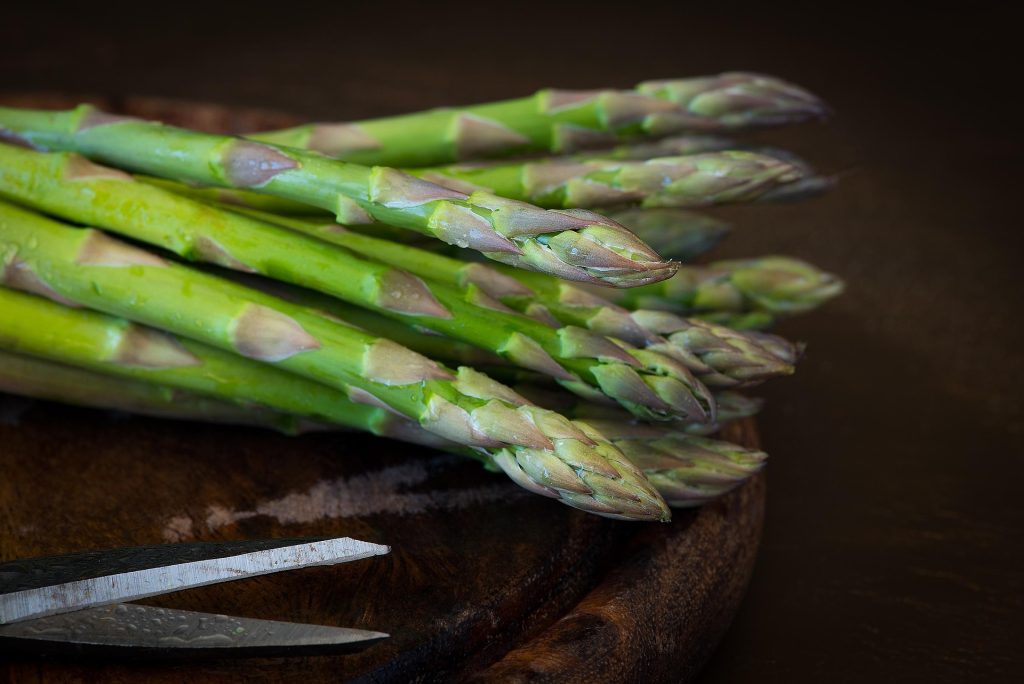
Asparagus pesto
Asparagus pesto is a fantastic way to use asparagus in a different form, and the taste is full of freshness and tempting aromas. Here’s a simple recipe:
Ingredients:
25 bunches of fresh asparagus
5 bunches of fresh parmesan (or other hard cheese of your choice)
5 bunches of cashews (or nuts of your choice, e.g. pine nuts, almonds or walnuts)
1-2 cloves of garlic (depending on the strength of the final flavour you want)
50 ml olive oil (add more if necessary)
The juice of 1/2 lemon
Salt and pepper (in as much as you prefer)
Fresh basil (optional)
Instructions:
Preparing the asparagus:
Wash the asparagus and cut off the tough bottom stalk
Cut it into smaller pieces (about 3-4 cm).
Blanching the asparagus:
Place the asparagus in a pot of boiling water and cook for 2-3 minutes until tender but still green.
Immediately transfer them to a bowl of cold water to stop the cooking process and preserve the colour.
Preparation of the pesto:
Place the blanched asparagus in a blender or food processor with the parmesan (or other hard cheese), pine nuts, garlic and lemon juice.
Start blending, adding olive oil little by little until you get your desired consistency.
The pesto should be generally smooth, but a little coarse in texture. Add more olive oil if necessary to make it easier to combine.
Seasoning:
Salt and pepper the pesto to your preference.
If you want, you can add a little fresh parsley or basil for extra flavour.
Serving:
You can serve the pesto as a spread on bread, or as an accompaniment to vegetables, meat or risotto, pasta, etc.
Asparagus soup
Ingredients:
40 bunches of fresh asparagus
1 small onion (finely chopped)
1 potato (medium-sized, peeled and diced)
2 cloves of garlic (finely chopped)
1 litre of vegetable stock (chicken stock can also be used)
100 ml of cooking cream
2 tablespoons of olive oil or butter
Salt and pepper to your preference
A little lemon zest (optional, for freshness)
Fresh parsley or chives for decoration (also optional)
Instructions:
Preparing the asparagus:
Wash the asparagus and cut off the bottom of the stalk.
Cut the asparagus into smaller pieces, leaving a few tips for decoration or adding them to the soup later.
Sautéing the vegetables:
Heat the olive oil or butter in a large pan or pot.
Add the chopped onion and garlic and sauté over medium heat until it becomes soft and translucent (about 5 minutes).
Add the chopped potatoes and asparagus and sauté for a few more minutes.
Add the stock:
Pour the stock over the vegetables and simmer for 15-20 minutes, until the vegetables are tender.
Blend the soup:
Once the vegetables and asparagus are tender, use a hand blender or portable blender to blend everything well into a smooth cream.
If you like, you can leave a few pieces of asparagus for texture or add them later.
Finish the soup:
Return the soup to the heat, add the cream and stir until everything is combined.
Season with salt and pepper to taste, add a little lemon zest for freshness (if you’re using it).
Serve:
Serve the soup in bowls, garnished with fresh parsley or chives. If you like, you can also add a little more cream or even toasted bread cubes for extra texture.
Asparagus Risotto
Ingredients:
300 g risotto rice (arborio)
1-2 bunches of fresh asparagus
1 onion (finely chopped)
2 cloves of garlic (finely chopped)
1 l vegetable stock (you can also use the water the asparagus was cooked in)
100 ml white wine (optional, but it gives extra flavour)
50 g parmesan cheese, grated
2-3 tablespoons olive oil
30 g butter
Salt and pepper to your preferred level, a few basil leaves
Instructions:
Preparing the asparagus:
Wash the asparagus and trim off the hard parts and stalks.
Cut the remaining asparagus into smaller pieces, leaving a few asparagus tips for decoration or adding to the risotto later.
Meanwhile, bring water to a boil and blanch the asparagus by cooking for 1-2 minutes. Then place it in ice water to keep the colour and crunch. This will also save some of the liquid for later.
Prepare the risotto:
In a large skillet or pot, heat the olive oil over medium heat.
Add the chopped onion and garlic and sauté for 2-3 minutes until it becomes soft and translucent
Add the rice and sauté briefly until translucent (for about 2 minutes).
If you’re using wine, now is the time to add it and cook until it evaporates.
Add the stock:
Start adding the stock, one ladle at a time, and stir the rice constantly until the liquid is absorbed. Continue adding the stock and stirring until the rice is creamy and al dente, which should take about 18-20 minutes.
Final steps:
When the risotto is ready, add the prepared asparagus (reserve a few pieces for garnish if you like).
Stir in the butter and grated parmesan to make the risotto even creamier.
Season with salt and pepper to your preferred level
Serving:
Serve the risotto hot, garnished with the remaining asparagus, basil, and additional parmesan cheese if desired.

